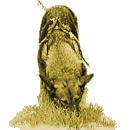>>>
Protection <<<
The final phase is the Manwork portion of the event. This phase is held after the obedience on the same field. The obedience equipment is removed and replaced with six hiding places (blinds) for the helper (decoy). See Figure 2 for layout. You will note that during this final phase, the dog is under complete control of the handler and is not allowed to touch the helper in any way except under attack or to prevent an escape. Even then, when commanded, the dog must release the grip immediately and guard the helper without touching him further.
The helper is placed in a blind out of sight of the dog. One team reports to the judge then proceeds down field to Blind 1. Upon command the dog searches the blind, the handler commands the dog to come and redirects him to Blind 2. This continues until the dog finds the helper. (5 points)
Upon discovery, the dog must not touch the helper in any way but indicates to the handler by barking that he has found the decoy. Upon the judge's request, the handler walks to within four paces of the dog. The dog must remain intently barking at the helper. The handler then calls the dog to the basic position. The handler orders the helper to leave the blind. The handler commands the dog to down. He leaves the dog to search the helper and then searches the blind. (5 points)
As the handler is searching the blind, the judge signals the helper who escapes by running swiftly. Without command, the dog must stop the escape by firmly gripping the padded protective arm. The judge signals the helper to stop the escape and stand firm. The handler commands the dog to release and guard. The dog must immediately release his grip and guard the decoy intently without touching him further. The judge then signals the helper to move aggressively forward into the dog waving a padded stick. The dog must immediately move into the attack without influence from the handler. He must firmly grip the helper to stop him from further aggression. When the dog has gripped firmly, two hits with the padded stick are executed. (The hits from the padded stick are carefully placed and are not painful but create a threatening sound.) Upon direction from the judge, the helper again stands still and the handler commands the dog to release the grip. The handler goes to the dog and commands him to the basic position. (35 points)
The handler directs the helper to move forward as the dog and handler heel 5 paces behind for a distance of 50 paces and two turns. (5 points)
After 50 paces, the helper will turn without warning and attack the handler. The dog must stop the attack without command. When directed by the judge, the helper stops the attack and stands still. The handler commands the dog to release and guard. The helper is then disarmed. The dog, handler, and helper then proceed to the judge who is 20 meters away. The dog is heeling between the handler and the helper and may not bother the helper during this side transport back to the judge.
After reporting to the judge, the team heels down field as the helper leaves and a second decoy moves into a blind midway down field. When the team is ready, the judge signals the helper out of hiding. The handler calls to the helper to stop, but he turns and runs away from the team. The handler calls again, but the helper ignores him. The handler then gives the command to pursue and releases the dog. When the dog is 40 paces away from the helper, the judge signals the helper to turn and charge at the dog threatening him with the padded stick. The dog must not show signs of intimidation, but continue the pursuit confidently into the grip. After "catching" the dog, the helper will briefly continue forward into the dog then stop the aggression. The handler who is at least 40 paces away, commands the dog to release and guard. Upon direction of the judge, the helper re-attacks the dog threatening with the padded stick. After the dog has gripped the protective arm firmly, the helper gives two stick hits and stops the aggression upon the judge's direction. The handler, who has not moved from his position 40 paces away, commands the dog to release and guard. When directed by the judge, the handler goes to the dog who has been intently guarding the decoy, and commands him to down. He then disarms the helper and takes the dog to the heel position, placing the dog between himself and the helper. The three proceed to the judge who is at least 20 meters away. The Attack, Pursuit, and Courage Test (10+10+25 = 45 Points)
After reporting to the judge. The team and the helper stand for critique. The critique is detailed and addressed to the audience.
The judge is required to
dismiss any dog who does not release the grip or who leaves the helper. He may
also dismiss a dog at his discretion should he feel the dog is not under
sufficient control.
